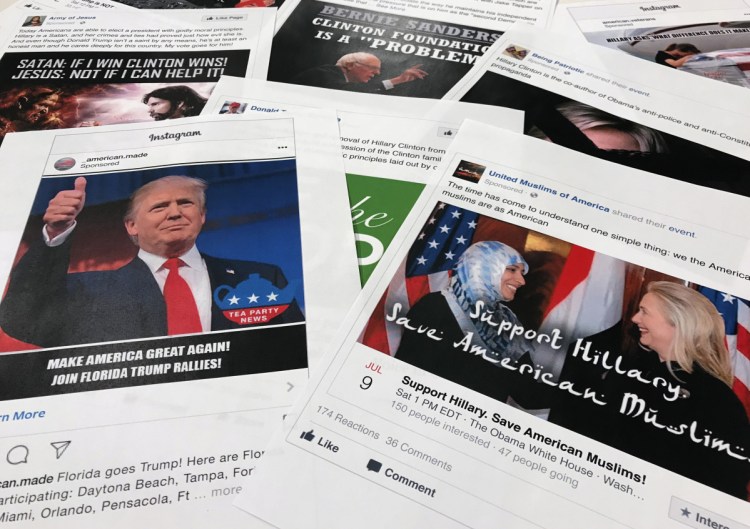Months after President Trump took office, Russia’s disinformation teams trained their sites on a new target: special counsel Robert Mueller III. Having worked to help get Trump into the White House, they now worked to neutralize the biggest threat to his staying there.
The Russian operatives unloaded on Mueller through fake accounts on Facebook, Twitter and beyond, falsely claiming that the former FBI director was corrupt and that the allegations of Russian interference in the 2016 election were crackpot conspiracies. One post on Instagram – which emerged as an especially potent weapon in the Russian social media arsenal – claimed Mueller had worked in the past with “radical Islamic groups.”
Such tactics exemplified how Russian teams ranged nimbly across social media platforms in a shrewd online influence operation aimed squarely at American voters. The effort started earlier than commonly understood and lasted longer while relying on the strengths of different sites to manipulate distinct slices of the electorate, according to a pair of comprehensive new reports prepared for the Senate Intelligence Committee and released Monday.
One, written by Oxford University’s Computational Propaganda Project and network analysis firm Graphika, became public when The Washington Post obtained it and published highlights Sunday. The other was by social media research firm New Knowledge, Columbia University and Canfield Research.
The researchers analyzed more than 10 million posts and messages on every major social media platform to understand how the Russians used American technology to build a sprawling online disinformation machine.
The reports also underscore the difficulty of defeating Russian disinformation as operatives moved easily from platform to platform, making the process of detecting and deleting misleading posts impossible for any company on its own to manage.
Twitter hit political and journalistic elites. Facebook and its advertising targeting tools divided the electorate into demographic and ideological segments ripe for manipulation, with particular focus on energizing conservatives and suppressing African-Americans, who traditionally are more likely to vote for Democrats.
YouTube provided a free online library of more than 1,100 disinformation videos. PayPal helped raise money and move politically themed merchandise designed by the Russian teams, such as “I SUPPORT AMERICAN LAW ENFORCEMENT” T-shirts. Tumblr, Medium, Vine, Reddit and various websites also played roles.
“These reports show Russia’s extensive efforts across several social media platforms to interfere in the 2016 election and undermine faith in our democratic institutions,” Maine Sens. Susan Collins and Angus King said in a joint statement. “This information will help support our ongoing work to find bipartisan solutions to prevent foreign influence without infringing on Americans’ First Amendment rights.”
Social media researchers said the weaponization of these sites and services highlights the broadening challenge they face in combating the increasingly sophisticated tactics of Russia and other foreign malefactors online.
“Some of the platforms that don’t have as much traffic, but still have highly engaged communities, are the most vulnerable to a challenge like misinformation,” said Graham Brookie, head of the Atlantic Council’s Digital Forensic Research Lab.
INSTAGRAM WAS OVERLOOKED
One unexpected star of the new reports Monday was Facebook’s photo-sharing subsidiary Instagram. Over the years of the disinformation campaign, Instagram generated responses on a scale beyond any of the others – with 187 million comments, likes and other user reactions, more than Twitter and Facebook combined.
But it had been the least scrutinized of the major platforms before this week as lawmakers, researchers and journalists focused more heavily on Facebook, Twitter and Google.
“Instagram’s appeal is that’s where the kids are, and that seems to be where the Russians went,” said Philip Howard, head of the Oxford research group.
The report anchored by New Knowledge found that the Russians posted on Instagram 116,000 times, nearly double the number they did on Facebook.
On Monday, the National Association for the Advancement of Colored People called for a weeklong boycott of Facebook starting Tuesday, saying the company’s business practices – and the spread of “disingenuous portrayals of the African-American community” on its site – should prompt further congressional investigation.
Facebook said in a statement that it has “made progress in helping prevent interference on our platforms during elections, strengthened our policies against voter suppression ahead of the 2018 midterms, and funded independent research on the impact of social media on democracy.”
The emergence of Mueller as a significant target also highlights the adaptability of the Russian campaign.
He was appointed in May 2017 as special counsel to investigate allegations of Russian influence on the Trump campaign. In that role, he has indicted the St. Petersburg-based Internet Research Agency, the Kremlin-linked troll farm behind the disinformation campaign on criminal charges.
A Clemson University research team, not affiliated with either of the reports released Monday, found that the Russians tweeted about Mueller more than 5,000 times, including retweets first posted by others.
Some called for his firing, while others mocked him as incompetent and still others campaigned for the end of his “entire fake investigation.”
Send questions/comments to the editors.



Success. Please wait for the page to reload. If the page does not reload within 5 seconds, please refresh the page.
Enter your email and password to access comments.
Hi, to comment on stories you must . This profile is in addition to your subscription and website login.
Already have a commenting profile? .
Invalid username/password.
Please check your email to confirm and complete your registration.
Only subscribers are eligible to post comments. Please subscribe or login first for digital access. Here’s why.
Use the form below to reset your password. When you've submitted your account email, we will send an email with a reset code.